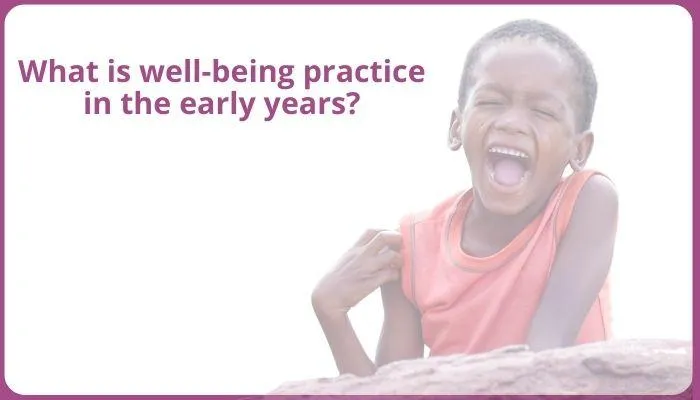Every child's well-being matters.
Well-being Articles

What does well-being practice look like for children in the early years?
Encouraging children to flourish into well-rounded individuals requires a concerted effort from parents, educators, and other influential figures. By fostering an environment filled with love, encouragement, and opportunities for growth, we contribute to their overall development.
In practical terms, this might involve spending 'proper', quality time with children, engaging in conversations that stimulate their curiosity, and actively participating in their interests. Whether it's physical activity, exploring nature, or pursuing creative endeavours, these experiences contribute significantly to a child's emotional and cognitive development.
In the realm of education, creating learning environments that cater to individual strengths and interests is essential. Providing a variety of learning materials, encouraging critical thinking, and allowing room for exploration help children develop a love for learning that extends in all areas of their life.
Instilling a sense of responsibility and independence is crucial for their social and emotional development. Teaching them to make choices, solve problems, and manage their time builds essential life skills that will serve them well in adulthood.
As children navigate the complexities of their early years, guidance and support become paramount. Open communication channels between parents, teachers, and caregivers ensure a cohesive approach to addressing challenges and fostering a positive atmosphere.
In conclusion, investing in the well-being of children goes beyond ensuring their basic needs are met. It involves actively engaging with their physical, emotional, social, and cognitive development. By providing a supportive and enriching environment, we empower children to grow into resilient, self-assured, and successful individuals, laying the groundwork for a fulfilling future.
AUTHOR:- Iona has nearly 10 years of experience supporting nurseries and childminders in curriculum planning, leadership, and safeguarding. Her writing is informed by public information and sector insight, aiming to provide accessible, practical support for professionals working with children. She is part of the On the Button team, helping deliver Well-being, Safeguarding and Complaint Management Software that empowers practitioners to identify concerns early and act confidently.
On the Button provides innovative software tailored to the needs of the early years sector, with a strong focus on EYFS well-being and early years safeguarding. Our tools help senior practitioners to confidently track concerns, maintain robust records, and respond effectively — all while meeting statutory guidance. From early years complaint management to team-wide safeguarding alerts, our platform puts children's safety and emotional health first.

What does well-being practice look like for children in the early years?
Encouraging children to flourish into well-rounded individuals requires a concerted effort from parents, educators, and other influential figures. By fostering an environment filled with love, encouragement, and opportunities for growth, we contribute to their overall development.
In practical terms, this might involve spending 'proper', quality time with children, engaging in conversations that stimulate their curiosity, and actively participating in their interests. Whether it's physical activity, exploring nature, or pursuing creative endeavours, these experiences contribute significantly to a child's emotional and cognitive development.
In the realm of education, creating learning environments that cater to individual strengths and interests is essential. Providing a variety of learning materials, encouraging critical thinking, and allowing room for exploration help children develop a love for learning that extends in all areas of their life.
Instilling a sense of responsibility and independence is crucial for their social and emotional development. Teaching them to make choices, solve problems, and manage their time builds essential life skills that will serve them well in adulthood.
As children navigate the complexities of their early years, guidance and support become paramount. Open communication channels between parents, teachers, and caregivers ensure a cohesive approach to addressing challenges and fostering a positive atmosphere.
In conclusion, investing in the well-being of children goes beyond ensuring their basic needs are met. It involves actively engaging with their physical, emotional, social, and cognitive development. By providing a supportive and enriching environment, we empower children to grow into resilient, self-assured, and successful individuals, laying the groundwork for a fulfilling future.
AUTHOR:- Iona has nearly 10 years of experience supporting nurseries and childminders in curriculum planning, leadership, and safeguarding. Her writing is informed by public information and sector insight, aiming to provide accessible, practical support for professionals working with children. She is part of the On the Button team, helping deliver Well-being, Safeguarding and Complaint Management Software that empowers practitioners to identify concerns early and act confidently.
On the Button provides innovative software tailored to the needs of the early years sector, with a strong focus on EYFS well-being and early years safeguarding. Our tools help senior practitioners to confidently track concerns, maintain robust records, and respond effectively — all while meeting statutory guidance. From early years complaint management to team-wide safeguarding alerts, our platform puts children's safety and emotional health first.

What does well-being practice look like for children in the early years?
Encouraging children to flourish into well-rounded individuals requires a concerted effort from parents, educators, and other influential figures. By fostering an environment filled with love, encouragement, and opportunities for growth, we contribute to their overall development.
In practical terms, this might involve spending 'proper', quality time with children, engaging in conversations that stimulate their curiosity, and actively participating in their interests. Whether it's physical activity, exploring nature, or pursuing creative endeavours, these experiences contribute significantly to a child's emotional and cognitive development.
In the realm of education, creating learning environments that cater to individual strengths and interests is essential. Providing a variety of learning materials, encouraging critical thinking, and allowing room for exploration help children develop a love for learning that extends in all areas of their life.
Instilling a sense of responsibility and independence is crucial for their social and emotional development. Teaching them to make choices, solve problems, and manage their time builds essential life skills that will serve them well in adulthood.
As children navigate the complexities of their early years, guidance and support become paramount. Open communication channels between parents, teachers, and caregivers ensure a cohesive approach to addressing challenges and fostering a positive atmosphere.
In conclusion, investing in the well-being of children goes beyond ensuring their basic needs are met. It involves actively engaging with their physical, emotional, social, and cognitive development. By providing a supportive and enriching environment, we empower children to grow into resilient, self-assured, and successful individuals, laying the groundwork for a fulfilling future.
AUTHOR:- Iona has nearly 10 years of experience supporting nurseries and childminders in curriculum planning, leadership, and safeguarding. Her writing is informed by public information and sector insight, aiming to provide accessible, practical support for professionals working with children. She is part of the On the Button team, helping deliver Well-being, Safeguarding and Complaint Management Software that empowers practitioners to identify concerns early and act confidently.
On the Button provides innovative software tailored to the needs of the early years sector, with a strong focus on EYFS well-being and early years safeguarding. Our tools help senior practitioners to confidently track concerns, maintain robust records, and respond effectively — all while meeting statutory guidance. From early years complaint management to team-wide safeguarding alerts, our platform puts children's safety and emotional health first.

What does well-being practice look like for children in the early years?
Encouraging children to flourish into well-rounded individuals requires a concerted effort from parents, educators, and other influential figures. By fostering an environment filled with love, encouragement, and opportunities for growth, we contribute to their overall development.
In practical terms, this might involve spending 'proper', quality time with children, engaging in conversations that stimulate their curiosity, and actively participating in their interests. Whether it's physical activity, exploring nature, or pursuing creative endeavours, these experiences contribute significantly to a child's emotional and cognitive development.
In the realm of education, creating learning environments that cater to individual strengths and interests is essential. Providing a variety of learning materials, encouraging critical thinking, and allowing room for exploration help children develop a love for learning that extends in all areas of their life.
Instilling a sense of responsibility and independence is crucial for their social and emotional development. Teaching them to make choices, solve problems, and manage their time builds essential life skills that will serve them well in adulthood.
As children navigate the complexities of their early years, guidance and support become paramount. Open communication channels between parents, teachers, and caregivers ensure a cohesive approach to addressing challenges and fostering a positive atmosphere.
In conclusion, investing in the well-being of children goes beyond ensuring their basic needs are met. It involves actively engaging with their physical, emotional, social, and cognitive development. By providing a supportive and enriching environment, we empower children to grow into resilient, self-assured, and successful individuals, laying the groundwork for a fulfilling future.
AUTHOR:- Iona has nearly 10 years of experience supporting nurseries and childminders in curriculum planning, leadership, and safeguarding. Her writing is informed by public information and sector insight, aiming to provide accessible, practical support for professionals working with children. She is part of the On the Button team, helping deliver Well-being, Safeguarding and Complaint Management Software that empowers practitioners to identify concerns early and act confidently.
On the Button provides innovative software tailored to the needs of the early years sector, with a strong focus on EYFS well-being and early years safeguarding. Our tools help senior practitioners to confidently track concerns, maintain robust records, and respond effectively — all while meeting statutory guidance. From early years complaint management to team-wide safeguarding alerts, our platform puts children's safety and emotional health first.
Quality Early Years Ltd.,
Dickens House,
Guithavon Street,
Witham, Essex,
England, CM8 1BJ
© Quality Early Years Ltd 2025
On the Button are Finalists for 3/3 Early Years Awards!
Find On the Button
on Social Media

